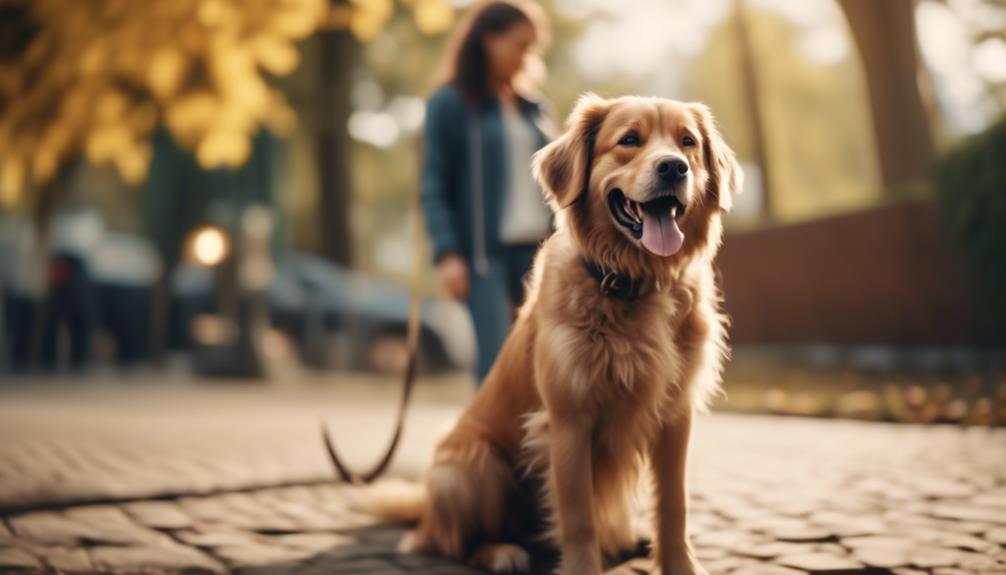How to Select a Dog Breed That Is Easy to Train

Tips for selecting a dog breed that is easy to train:
- Understand the characteristics of different breeds
- Find one that aligns with your training goals.
Key Takeaways
- Research and understand the characteristics of different breeds to find one that is easy to train
- Look for breeds known for trainability, such as Border Collies, Poodles, Papillons, Bernese Mountain Dogs, and German Shepherds
- Assess the breed's intelligence level and look for breeds with higher focus and less distractibility
- Consider dogs with a strong desire to please, like Golden Retrievers and Papillons, as they are eager to learn and respond well to positive reinforcement
Consider Your Lifestyle and Living Situation
Consider your lifestyle and living situation when selecting a dog breed that will be easy to train. The amount of time and energy you can dedicate to training should be taken into account.
If you lead an active lifestyle with plenty of time for exercise and mental stimulation, breeds like the Golden Retriever, Border Collies, and Bernese Mountain dog may be suitable options. These breeds are known for their intelligence and eagerness to please, making them easier to train.
On the other hand, if you have a more sedentary lifestyle or limited space, you may want to consider a breed like the German Shepherd or Shetland Sheepdog, which are also highly trainable but require less physical activity.
Additionally, smaller breeds like Miniature Poodles or Labrador Retrievers can be a good fit for apartment living, as long as they receive adequate exercise and mental stimulation.
It's important to research and understand a breed's activity level and adaptability to ensure a harmonious fit with your lifestyle and living situation. By considering these factors, you can select a dog breed that will be easier to train and integrate into your life.
Research Breeds Known for Trainability

When selecting a dog breed that will be easy to train, it is important to research breeds known for their high trainability. Certain breeds are more receptive to learning and following commands, making the training process smoother and more successful. Here are some breeds that are known for their trainability:
| Breed | Trainability |
|---|---|
| Border Collie | Very high |
| Poodle | Very high |
| Papillon | High |
| Bernese Mountain Dog | High |
| German Shepherd | High |
These breeds are considered intelligent and eager to please, making them excellent candidates for training. They thrive on mental stimulation and obedience training, which allows them to learn and understand commands more quickly. In addition to their trainability, it is important to provide these breeds with sufficient physical exercise to keep them mentally and physically balanced.
When researching breeds, consider their traits and characteristics that are conducive to training. Look for breeds with high focus, good health, and energy levels that match your lifestyle. Golden Retrievers, German Shepherds, and Labrador Retrievers are also known for their eagerness to learn and please their owners. By choosing a breed with a natural inclination towards learning and obedience, you are setting yourself and your dog up for a successful training experience.
Assess the Breed's Intelligence Level

Assessing the breed's intelligence level is crucial when selecting a dog that will be easy to train. A dog's mental capabilities play a significant role in their ability to learn new tricks and commands. Here are five key factors to consider when evaluating a breed's intelligence:
- Highly intelligent breeds like Border Collies are often easier to train due to their quick learning and ability to follow commands.
- Breeds with historical working roles, such as German Shepherds, are genetically predisposed to understanding commands, making them easier to train.
- Look for breeds with higher focus and less distractibility, as they're generally easier to train and more receptive to commands.
- Younger dogs are generally easier to train and can build on previous training, while older dogs may be more stubborn and resistant to training.
- Regardless of age, training success depends on the commitment and consistency of the trainer. Consider your own ability to provide consistent training.
Look for Dogs With a Strong Desire to Please

Look for dog breeds that exhibit a strong desire to please their owners, as this trait greatly contributes to their ease of training. Dogs that are eager to please, such as Golden Retrievers and Papillons, are highly intelligent and motivated to learn. Their willingness to make their owners happy makes them responsive to positive reinforcement, which in turn makes training more effective and enjoyable for both the dog and the owner.
When you have a dog that's eager to please, they'll pick up new commands quickly and retain the information for future use. Their strong desire to make you happy means they'll be attentive and focused during training sessions. This can help keep your dog engaged and motivated to continue learning new things.
To teach your dog effectively, use training tips that emphasize positive reinforcement and rewards. Dogs with a strong desire to please thrive on praise and treats, so make sure to provide plenty of both during the training process. Remember to keep the sessions short and frequent, as these breeds can become bored easily.
Consider the Breed's Energy Level and Exercise Needs

Are you considering a dog breed that matches your energy level and exercise needs? When selecting a dog breed that's easy to train, it's important to consider the breed's energy level and exercise needs. Here are some key points to keep in mind:
- High-energy breeds like Border Collies and Australian Shepherds are agile and intelligent, but they require intense physical activity and mental stimulation to thrive and be easily trainable.
- Breeds with lower energy levels, such as the Bernese Mountain Dog, may be more receptive to training with moderate exercise needs. This makes them easier to train for owners with less active lifestyles.
- Matching the breed's energy level to the owner's ability to provide the necessary exercise and stimulation is crucial for successful training and overall well-being.
- Understanding the breed's exercise requirements can help in selecting a dog that fits the owner's lifestyle and ensures a harmonious training experience.
- Considering a breed's energy level and exercise needs is essential for setting realistic training goals and ensuring a happy and healthy relationship with the dog.
Evaluate the Breed's Temperament and Socialization Requirements

Understanding the breed's temperament and socialization requirements is crucial when selecting a dog breed that is easy to train. Evaluating these aspects will help determine how well a dog will respond to training and interact with their environment. Consideration of a breed's socialization needs is important to ensure that they receive proper exposure to various environments, people, and animals. This exposure promotes well-rounded behavior and helps prevent fear or aggression issues. It is also beneficial to choose a breed that is known for being adaptable and sociable, as they tend to be easier to train in different situations and around various people.
To help you evaluate a breed's temperament and socialization requirements, here is a table outlining some key considerations:
| Temperament | Socialization Requirements |
|---|---|
| Friendly and outgoing | Needs frequent exposure to different people and animals |
| Calm and relaxed | Requires consistent socialization to prevent anxiety |
| Eager to please | Benefits from positive reinforcement training methods |
When starting to train your new dog, it is important to pay attention to their body language. This will help you understand their emotions and adjust your training approach accordingly. It is recommended to start training early, as puppies are more receptive and eager to learn. Focus on teaching basic commands and gradually increase the difficulty level. Keep in mind that mental and physical stimulation are equally important for a well-trained and happy dog.
Seek Professional Advice and Guidance

Consider consulting with a professional dog trainer or behaviorist for expert advice and guidance when selecting an easy-to-train dog breed. These professionals have the knowledge and experience to help you choose the right dog and provide you with valuable insights on training techniques and methods.
Seeking professional advice can greatly benefit you and your dog in several ways:
- They can assess your lifestyle and preferences to recommend breeds that are easy to train and suit your needs.
- They can provide guidance on training methods that focus on positive reinforcement and encourage good behavior.
- They can help you understand the importance of mental health and physical stimulation for your dog, ensuring they receive the necessary exercise and mental stimulation.
- They can assist in addressing any behavioral issues or challenges that may arise during the training process.
- They can teach you effective communication techniques to establish a strong bond with your dog and enhance the training experience.
Frequently Asked Questions
Which Dog Breed Is Easiest to Train?
Some highly intelligent dog breeds, like Border Collies and German Shepherds, are known for their ease of training. Their intelligence and trainability make them a popular choice for owners looking for a trainable companion.
What Is the Most Easily Trained Dog?
The most easily trained dog breeds are the Border Collie, Poodle, Papillon, Bernese Mountain Dog, and German Shepherd. They possess characteristics like intelligence, loyalty, and obedience that make training them a breeze.
What Breed of Dog Is Hardest to Train?
The hardest breed to train varies depending on individual temperament and characteristics, but some breeds, like Shiba Inus, may present challenges due to resistance and stubbornness. Experienced handlers and commitment to training are necessary.
What Is the Easiest Type of Dog to Own?
The easiest type of dog to own is one that fits your lifestyle and needs. Look for low maintenance, family-friendly breeds with a calm temperament and minimal exercise requirements. Consider hypoallergenic, intelligent breeds that are easy to groom and have minimal barking tendencies.









